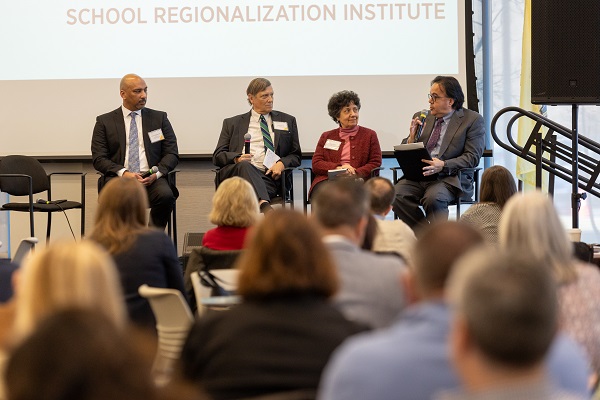Experts discuss the path to school regionalization at Sweeney Center conference
Experts discuss the path to school regionalization at Sweeney Center conference

When it comes to the complicated path to regionalizing schools, educational leaders and communities need to focus on putting students first.
That was a key message shared by educational experts from around the state who explored the benefits and barriers of regionalization during “School Regionalization in New Jersey: Issues, Opportunities and Challenges,” a conference presented by the Steve Sweeney Center for Public Policy at Rowan University on Feb. 7.
The half-day conference, which included a dozen of New Jersey’s top educational leaders, was designed to assess the impact of the S3488 school regionalization law, make recommendations on policies to advance regionalization and conduct regionalization studies for interested districts. The law was passed in 2022. With its enactment, schools could receive funding for feasibility studies and implementation of regionalization.
Through regionalization, small school districts can improve the educational experiences of students while reducing long-term costs, former New Jersey Education Commissioner Lucille Davy said. She noted that, across New Jersey, many small school districts serve just a couple hundred students in pre-K through 8th grade. Once those students move on to a larger regional high school, gaps in school resources become apparent, Davy said.
Davy is one of a handful of experts on the Rowan School Regionalization Institute team, which was formed by the Sweeney Center and the University’s College of Education to assess the impact of the new school regionalization statute.
Differences among districts
Conference panelists noted that, in subjects that range from math to music, the differences among individual districts’ curricula, resources and supports for educators lead to unequal levels of knowledge among students. Small districts often lack the funding to hire the academic support students need, like specialists in math, reading and science.
The situation, panelists explained, is hard on everyone involved, including students from sending districts struggling to catch up, their classmates whose education gets disrupted, and the teachers who are trying to give all students the best possible education.
“A continuous K-12 system where everything is integrated and there’s a common focus on how you’re delivering the educational program really is beneficial to the students and helpful to your teaching professionals,” said Davy.
Until recently, small school districts that wanted to regionalize couldn’t afford to, said Jacquelyn Suarez, acting commissioner of the New Jersey Department of Community Affairs. In fact, longstanding state law served to “block regionalization under all circumstances by creating as many barriers” as possible," said Mark J. Magyar, director of the Sweeney Center.
“Nine times out of 10, we heard from the municipalities that they really wanted to do it, but they were going to have to outlay some of the costs upfront,” Suarez explained.
Grants to support regionalization efforts
A critical component of NJ S3488 is providing school districts with School Regionalization Efficiency Program grants to study regionalization, as well as Local Efficiency Achievement Program implementation grants to cover costs for districts that decide to regionalize, panelists noted.
Regionalization has been a decades-long effort for the Highlands, Atlantic Highlands and Henry Hudson Regional High School districts in Monmouth County. Superintendent Dr. Tara Beams shared how the Henry Hudson Tri-District has attempted continuity of curriculum and resource sharing throughout the years before deciding to move forward with a regionalization vote that passed overwhelmingly in September.
In July, the Henry Hudson Regional School District will become the first pre-K-12 regionalization to go into effect under the new law.
A clear vision of where the tri-district wanted to go, combined with a comprehensive feasibility study, helped the districts determine their path forward, she said.
“Regionalization doesn’t start with your feasibility study. It doesn’t start with a petition of the commissioner,” Beams said. “It does have to come from within the school district because they have that innate understanding of what the obstacles are.”
Assessing challenges
Despite the advantages, there are still challenges in the regionalization process, panelists explained. Speakers Dr. Brian Falkowski, chief executive officer of SBO Management LLC, and Dr. Michael Gorman, president of Salem Community College, joined Beams in a panel on the dos and don’ts of school regionalization. Concerns range from regionalization potentially fostering segregation to geographic separations that, in some districts, could mean young children spend an hour commuting to a distant school.
“There are only a few ways for this to go right, and there are a thousand ways for this to go wrong,” Gorman said.
“One of the key components here is that any type of regionalization be for the educational benefit of the students involved,” said Peter Vala, director of research at the New Jersey Education Association.
Whether they have already started conducting feasibility studies or are still getting acquainted with the unification process, school board members and administrators left the conference with plenty of information regarding the potential benefits of regionalization and the grant funding available.
Addressing 'equity of opportunity'
Chief Richard Richardella of the Local Government Assistance Bureau in the New Jersey Department of Community Affairs discussed grant opportunities under the School Regionalization Efficiency Program. Consultants G. Kennedy Greene and Dr. Scott Oswald explained the feasibility study process districts undertake as one of the first steps to unification.
Greene and Oswald serve on the Rowan School Regionalization Institute with Davy, Magyar and Rowan Professor David Lindenmuth, a former superintendent of four school districts in South Jersey and director of the Rowan Institute for Educational Leadership in the College of Education.
Regionalization improves equity of opportunity in New Jersey schools, Lindenmuth said.
“Every community is different, and that's why this is a complicated issue,” he said. “In some districts, you don't have the money for professional development for your teachers to improve and to grow. Is that fair for those students? If you look at it from that standpoint, and most regards, I think school regionalization makes sense.”